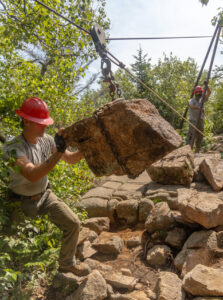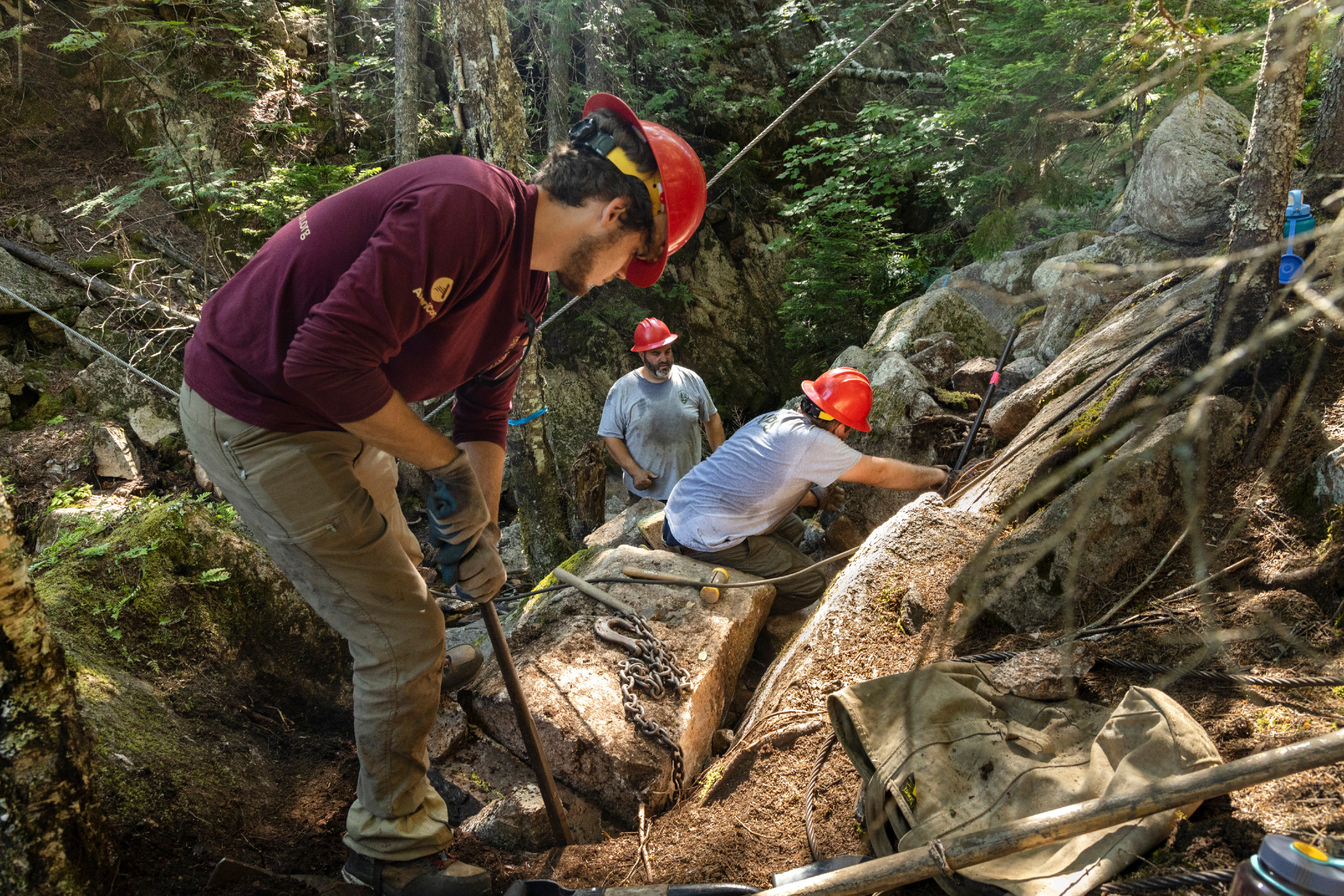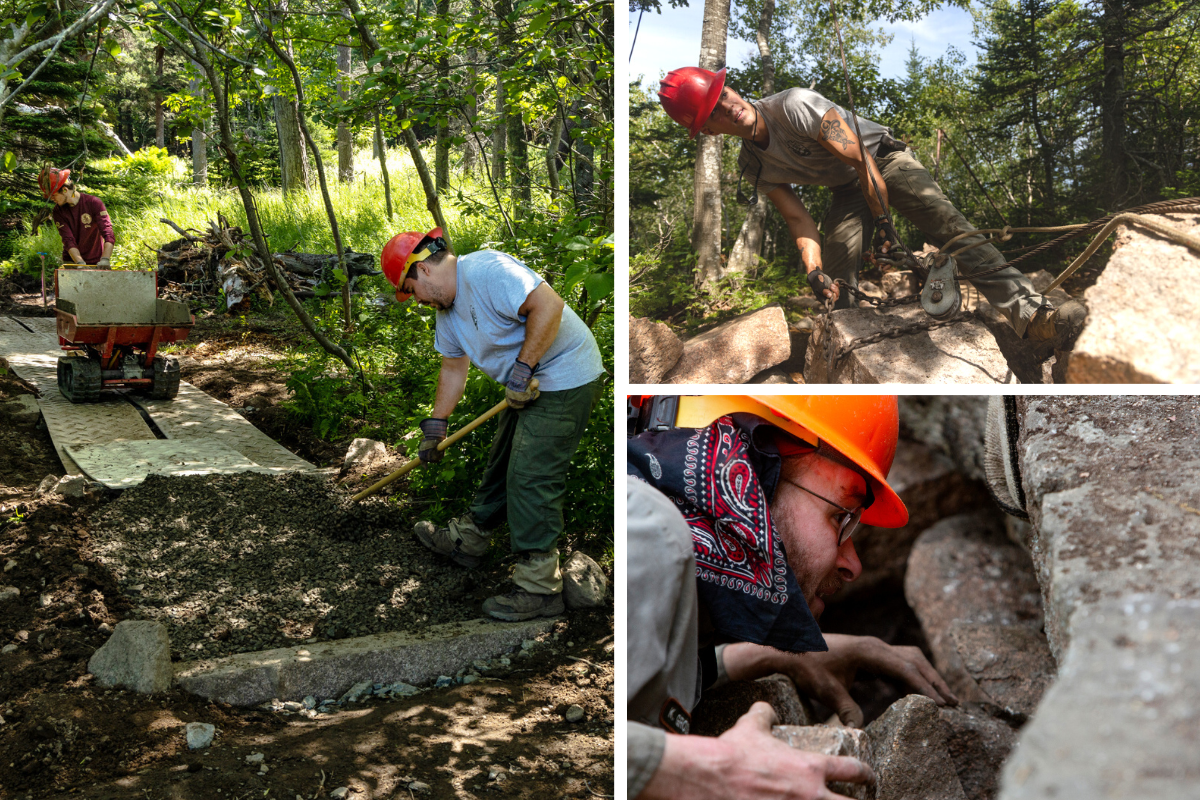Building Trails That Last
Moving heavy rock is a big part of building and maintaining trails in Acadia National Park. But there’s so much more to it.
October 27th, 2023
Moving heavy rock is a big part of building and maintaining trails in Acadia National Park. But there’s so much more to it.
October 27th, 2023

Zach Dixon of the Acadia National Park trail crew uses a highline system to move pieces of granite to build steps during maintenance
on Cadillac North Ridge Trail. (Photo by Sam Mallon/Friends of Acadia)
BY SHANNON BRYAN
On a humid August day on the north ridge of Cadillac Mountain, a voice calls out from the trees not far off the trail: “Up and out!”
A few moments later, a rectangular hunk of pink granite—weighing somewhere in the ballpark of 800 pounds—moves into view, hovering a few feet above the forest floor like a magic carpet. Wrapped in heavy chain, it continues its slow drift forward along a braided steel cable, nudging aside the birch, oak, and spruce branches as it passes.
Acadia Trail Crew Member Zach Dixon stands nearby on the trail amid similarly sized rocks—some in small piles at the trailside and others already assuming their place as part of the trail’s granite staircase. Dixon watches the floating granite block approach and reaches his hands out to receive it, calling out to the person in the trees to halt.
“Down when ready!” Dixon shouts.
“Coming down!” is heard in return.
As the granite comes down for its slow-motion landing, Dixon gives it a push and guides it down so it will come to rest where he wants it. Highlines and chains and grip hoists are supremely helpful for moving heavy rock, but human hands are still necessary for fine-tuning.
Granite comprises many of the park’s prolific onward-and-upward staircases as well as rock walls, steppingstones, and bridge abutments. Moving that granite is physical and challenging.
But well before that granite is lifted from a nearby natural quarry or hefted into place by human hands, the trail crew does a great deal of planning. That planning begins years in advance, said Acadia National Park Trails Foreman Dave Schlag, upwards of a decade sometimes.
“We get out there and we look at what is going on, whether it’s damage from people, damage from weather, climate change or old age,” said Schlag. “Or is it just like the first step that was ever set in Acadia and it’s starting to wiggle. We take a look at all of that, and we start formulating.”
Acadia’s Trail Crew is tasked with keeping Acadia’s trails safe and looking sharp.
Simultaneously, they need to maintain the trails’ historic integrity while likewise accommodating for increased visitation that puts added pressure on every trail. They consider water flow and how best to mediate the effects of erosion, and they work in ways that are least disruptive to the area’s wildlife and vegetation.
It’s a lot to consider. But they find an impressive balance between preserving nature and park history while having to make adjustments to both.
“This is a big balance. You don’t want to change the historical aspects of a trail, but you’ve got to build for what’s going on now,” said Schlag. “One of the biggest things we deal with is visitor use. It’s increased a lot.”
In the early 1900s, Acadia’s trails and stone paths saw use from June to August from decidedly fewer visitors than come to the park today. The season is longer now, extending right through the winter for some hikers.
But there is no one-size-fits-all approach. For each project, Schlag and his crew look to the expertise of park staff in multiple departments, including wildlife, natural resources, and cultural history.
“We’ll go out with Gail Gladstone, the park’s cultural historian, a couple of seasons in advance and during a project,” said Schlag. “We’ll get her input on things like maintaining the historical aspects and the feel of the trail or the landscape we’re working in.”
“Each trail has a different historic feel, so the stonework might look different,” Schlag said. “A staircase over on Beech Mountain is going to look different than a traditional staircase on Dorr Mountain.”
They collaborate with others, like Acadia National Park Vegetation Manager Jesse Wheeler, Wildlife Biologist Bik Wheeler, and Wildlife Biological Technician Morgan Ingalls, who’s particularly well versed on Acadia’s bats and where they roost.
“We get out 12-18 months in advance and look at these areas and say, what do you guys think? Are there bats living in these areas? Are there vernal pools? Any kind of frog or salamander habitat?” said Schlag. “We look at every individual tree before we cut it, and if they say ‘no,’ then okay, that means we’ve got to bend the trail this way a little bit.”
After brainstorming all the possible ideas, they zero in on the best one.

Acadia National Park Trail Crew member Amy Brown (right) breaks up larger rocks along the Long Pond (Great Pond) Trail, in order to make the trail easier to walk on, on Tuesday, September 13, 2022 in Acadia National Park. (Photo by Sam Mallon/Friends of Acadia)
Maine’s granite comes in heavy and handy.
“A 3-by-3-foot block could be 600 to 1,000 pounds,” said Schlag. Moving it takes time, effort, and equipment.
When possible, that rock is sourced from natural granite quarries not far from the trail. It’s transported from the quarry to the trailside with a highline—a braided steel cable with a rope core, which allows it to have a little bit of flex.
That cable is anchored on each end, sometimes to an anchor stone or really robust tree. They use tall steel tripods, too, which are built in house. “Acadia is unique, and the normal landscape or forestry tools don’t always apply to us,” said Schlag. “We’ve got some cool custom stuff.”
The upside to that weighty stone, though, is that it lasts.
“That material allows it to stand up to the weather,” said Schlag. “You put that 1,000-pound rock in the ground and it’s not going anywhere.” Although, Schlag notes, if you just stick it in the ground, it will sink.
“A lot of the old staircases were built right in the dirt. They’d dig a hole in the ground and put a rock in there and start stacking up stairs. Over time, 50, 60, or 100 years, the steps start to sink into the ground, they start to tilt out of level.”
The modern-day approach uses crushed stone to allow water to drain under the stairs and keeps the granite slabs in place.
“We like to build the drainage right into it. We’ll lay a crushed stone foundation under the whole thing. We quarry rocks right out of the woods, we crush them by hand, and the stones get reset right on top of that bed of crush.”
Other useful tools for moving heavy rock: rugs and duct tape.
To protect nearby trees as heavy rocks are being highlined by, trail crews duct tape small rugs around the trunks to protect the bark from any gouges. They also transplant native vegetation to fill in any holes made from quarrying granite or to fill in around a recently built trail.
They’re seemingly simple but thoughtful ways the trail crew takes care of the land.
“The trails are in these areas for a reason,” said Schlag. Damaged trees and upturned earth change the landscape and visitors’ experiences.
The goal is to keep the trails as beautiful as they’ve been.
If done well, said Dixon, “These rocks will sit here for another hundred years.”

Cooper Dees with the American Conservation Experience, Acadia Trails Foreman Dave Schlag, and crew member Kyle Sainio work to reroute a section of Giant Slide Trail that washed out after flooding in 2021. (Photo by Lily LaRegina/Friends of Acadia)
Historically, the average trail crew is 20 strong. This year they have nine. “It’s not for a lack of trying,” said Schlag. Both the tight labor market and lack of workforce housing are factors.
Fortunately, the dedicated crew gets support from a range of volunteer groups, including the Appalachian Mountain Club’s Roving Conservation Crew (RCC), Sierra Club volunteers, as well as the Acadia Youth Conservation Corps and Friends of Acadia’s stewardship volunteers and service groups.
Schlag’s been working on the trails crew for 14 years, initially hired as a seasonal in 2010, and he digs the work for the same reasons his crew does.
“I love the crew and the camaraderie. I really like the variety of work we do here. It’s not the same thing every day,” he said. “Some days you’re building a stone staircase, some days you’re building a log structure. Some days you’re building a gravel trail, running equipment, doing carpentry or tree work.”
“The crew take a lot of pride in their work,” said Schlag. And it feels good, he added, “knowing that you built something and someone else is going to enjoy it.”

Left: Cooper Dees, left, and Kyle Sainio, pack gravel down on a section of newly constructed trail on Great Head. (Photo by Lily LaRegina/Friends of Acadia). Top right: Zach Dixon of the Acadia National Park Trail Crew uses a highline system to move pieces of granite to build granite steps on Cadillac. (Photo by Sam Mallon/Friends of Acadia). Bottom right: Kyle Grossman uses broken rocks to level and stabilize the walkway. (Photo by Ashley L. Conti/Friends of Acadia)
SHANNON BRYAN is Friends of Acadia’s Content and Website Manager.